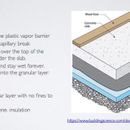Should XPS insulation be placed directly below slab?
We have been told never to place XPS foam insulation directly below the slab due to the fact that if the XPS gets wet, it could hold the moisture indefinitely. It was advised to place a 10mil vapor barrier below the slab followed by the Insulation layer, then 4” granular base. Contractors in our area usually reverse the insulation and vapor barrier’s position making the foam directly under the concrete. Is there a way that’s best to prevent moisture issues?
*photo of what’s been recommended.
GBA Detail Library
A collection of one thousand construction details organized by climate and house part










Replies
XPS won't readily absorb water so there's not much danger there. The main reason for placing the vapor retarder above the foam is to keep the foam from floating up into the slab when the concrete is placed.
The person who recommended placing the insulation under the vapor barrier said it would help prevent moisture from moving into the home if the insulation did become wet, that it would block moisture from wicking up into the finished concrete floor. Maybe that’s not accurate?
That doesn't make sense. The vapor retarder should block moisture no matter where it is in the assembly.
There's no good reason to use XPS over EPS under a slab. EPS is cheaper, exponentially less environmentally damaging*, and is available in whatever compressive strength you might require. EPS does take on water a little more readily, but it sheds it much more readily than does XPS. Both are allowed by code, so having someone tell you "only use extruded polystyrene insulation" is a bit ridiculous.
Thank you Trevor. If we use EPS what’s your thoughts on placing it directly below the slab? Should it be placed under the 10 mil vapor barrier that way if it does take on any moisture it’s separated from the finished floor? (We are using the concrete slab as our finished floor).
The barrier should be between the slab and the insulation, for the reason Michael Maines gave. I kind of agree with the reasoning in comment #4, if only because there's a chance of the barrier getting damaged being placed directly on gravel. That's only a hypothetical, I don't really know if that would happen in practice. There's no good reason to put the barrier under the insulation.
Emil,
Apart from the problems of the foam moving during the pour, the poly needs to be directly under the slab to stop the concrete bleed water from being trapped under the foam, where it can take months to dry out.
https://www.greenbuildingadvisor.com/article/polyethylene-under-concrete-slabs
dupont has a document -- Tech Solutions 511.0 DuPont™ Styrofoam™ Brand Extruded Polystyrene Foam Insulation for Foundations. it's a PDF file so i didn't include the link.
the directions say to put the 10 mil poly on top of the insulation, likely for some of the same reasons malcolm and michael stated. there may be similar documentation from EPS manufacturers.